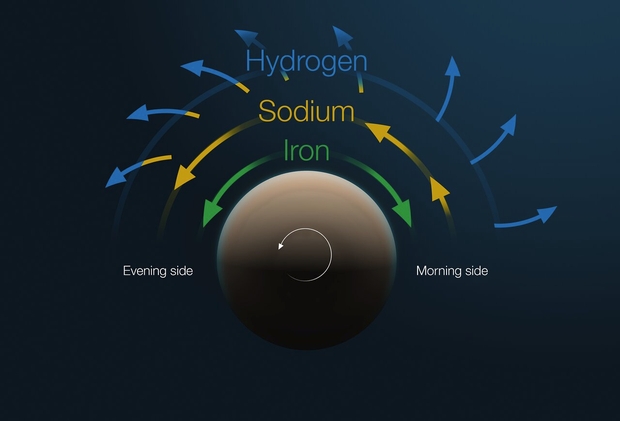Some 900 light years away in the constellation Puppis, the planet WASP-121b is proving an interesting test case as we probe ever deeper into exoplanetary atmospheres. As has been the case with so many early atmosphere studies, WASP-121b, also known as Tylos, is a hot-Jupiter, with a year lasting about thirty Earth hours, in a vise-like tidal lock that leaves one side always facing the star, the other away. What we gain in two new studies of this world is an unprecedented map of the atmosphere’s structure.
At stake here is a 3D look into what goes on as differing air flows move from one side of the planet to the other. A jet stream moves material around its equator, but there is a separate flow at lower altitudes that pumps gas from the hottest regions to the dark side. “This kind of climate has never been seen before on any planet,” says Julia Victoria Seidel (European Southern Observatory), lead author of a paper that appears today in Nature. Seidel points out that we have nothing in the Solar System to rival the speed and violence of the jet stream as it crosses the hot side of Tylos.
The astronomers used the European Southern Observatory’s Very Large Telescope, combining all four units to parse out the movement of chemical elements like iron and titanium in the weather patterns produced by these layered winds. What’s particularly significant here is the fact that we are now able to delve into an exoplanet atmosphere at three levels, analyzing variations in altitude as well as across varying regions on the world, and finally the interactions that produce weather patterns, form clouds and induce precipitation. Such 3D models take us to the greatest level of complexity yet.
“The VLT enabled us to probe three different layers of the exoplanet’s atmosphere in one fell swoop,” says study co-author Leonardo A. dos Santos, an assistant astronomer at the Space Telescope Science Institute in Baltimore. Tracking the movements of iron, sodium and hydrogen, the researchers could follow the course of winds at different layers in the planet’s atmosphere. A second paper, published in Astronomy & Astrophysics, announced the discovery of titanium in the atmosphere.

Image: Structure and motion of the atmosphere of the exoplanet Tylos. Astronomers have peered through the atmosphere of a planet beyond the Solar System, mapping its 3D structure for the first time. By combining all four telescope units of the European Southern Observatory’s Very Large Telescope (ESO’s VLT), they found powerful winds carrying chemical elements like iron and titanium, creating intricate weather patterns across the planet’s atmosphere. The discovery opens the door for detailed studies of the chemical makeup and weather of other alien worlds. Credit: ESO.
Note what we have in the image above. The paper describes it this way:
…a unilateral flow from the hot starfacing side to the cooler space-facing side of the planet sits below an equatorial super-rotational jet stream. By resolving the vertical structure of atmospheric dynamics, we move beyond integrated global snapshots of the atmosphere, enabling more accurate identification of flow patterns and allowing for a more nuanced comparison to models.
And that’s the key here – refining existing models to pave the way for future work. Digging into the 3D structure of the atmosphere required the VLT’s ESPRESSO spectrograph, collecting four times the light of an individual instrument to reveal the planet as it transited its star, a F-class star with mass and radius close to that of the Sun. Planet Tylos is named after the ancient Greek name for Bahrain, as part of the NameExoWorlds project. The host star bears the name Dilmun after the ancient civilization emergent on a trade route in the region after the 3rd millennium BC.
The Seidel et al. paper notes that existing Global Circulation Models (3D) do not fully capture what is observed at WASP-121b, making scenarios like these valuable testbeds for advancing the state of the art. Extremely Large Telescopes now under development will be able to put these refined models to work as they broaden the study of exoplanet atmospheres in extreme conditions:
The discrepancy between GCMs and the provided observations highlight the impact of high signal-to-noise ratio data of extreme worlds such as ultra-hot Jupiters in benchmarking our current understanding of atmospheric dynamics. This study marks a shift in our observational understanding of planetary atmospheres beyond our solar system. By probing the atmospheric winds in unprecedented precision, we unveil the 3D structure of atmospheric flows, most importantly the vertical transitions between layers from the deep sub-to-anti-stellar-point winds to a surprisingly pronounced equatorial jet stream. These benchmark observations made possible by ESPRESSO’s 4-UT mode serve as a catalyst for the advancement of global circulation models across wider vertical pressure ranges thus significantly advancing our knowledge on atmospheric dynamics.
The papers are Seidel et al., “Vertical structure of an exoplanet’s atmospheric jet stream,” Nature 18 February 2025 (abstract) and Prinoth et al., “Titanium chemistry of WASP-121 b with ESPRESSO in 4-UT mode,” in process at Astronomy & Astrophysics (preprint).



It is so beyond crazy to think that just a few decades after our first insights into the atmospheres of planets in our own back yard (solar system), we now can make confident pronouncements about the 3D atmospherical dynamics of planets in a systems almost 1000 light years away!!
I cannot tell from the image how the full circulation is done. Where are the return flows – away from the lower latitudes to the mid-latitudes or, perhaps over the poles? How is the iron source replenished?
Does the sodium wind circle the planet returning to the dayside, or is to symmetric on both hemispheres and needing a replenishing source for the dayside?
Hi Paul
One extreme planet here but probably similar to all the other close in hot Jupiters found to date, the Hydrogen is most likely being lost as well.
Thanks Edwin